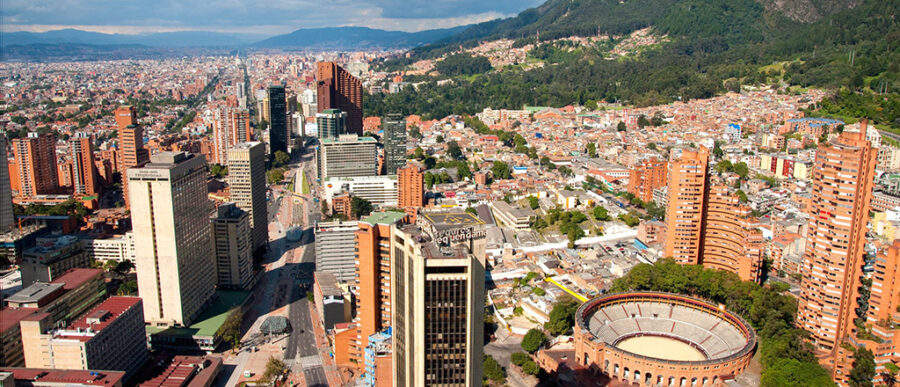The Revolutionary Armed Forces of Colombia — known in Spanish as FARC – have reached a final peace agreement with Colombian president Juan Manuel Santos, following a ceasefire pact that the two sides reached in June. Although the peace agreement, which marks the end of the last major armed conflict in the Americas, will require a referendum subject to public approval, the accord has already been viewed as an historic step towards ending a brutal war that went on for a half century.
The FARC guerrillas, established during the Cold War as an “anti-imperialist,” Marxist-Leninist peasant force, have been funded through kidnapping, ransom, drug-trafficking and other criminal activities. The peace agreement was expected to be formally announced August 24 from Cuba – where negotiations began in 2012. If it is ratified by the Colombian people, the initial phase of the FARC’s demobilization program is expected to take about six months. At the end of that period, all FARC members will have been demobilized and disarmed, and will either take part in a reintegration program or a criminal trial, in the case of those who are accused of human rights violations. In the past, the FARC has been classified as a terrorist organization by the governments of Colombia, the United States, Canada, Chile, New Zealand and the European Union.
The peace agreement comes at a time when Colombia is looking to attract the foreign investment it needs to cement its status as one of Latin America’s emerging free-market, middle-income nations. Despite the ongoing civil war, Colombia’s per capita GDP steadily expanded from $1200 in 1980 to $6,060 in 2015, according to data from the World Bank. In recent years, Colombia’s progress stood out in stark contrast with the disastrous decline in neighboring Venezuela, whose government has pursued an anti-capitalist course under late president Hugo Chavez and his successor, Nicolas Maduro.
More recently, however, Colombia’s GDP growth rate has declined to about 3% in 2015, compared with 4.4% growth in 2014, because of slumping prices for its exports of crude oil, and weaker demand from China for its other commodity exports. If history is any guide, a successful completion of the peace process will have a major positive impact on Colombia’s growth, says Wharton management professor Mauro Guillen, who is also director of The Lauder Institute. “When you take a look at parts of the world where there was a protracted conflict, including terrorism, and then there was a peace process, there has been an economic boom” after the peace. The most recent such case involved Northern Ireland, where the Good Friday agreement with the Republic of Ireland was signed in 1998. “Since that agreement nearly 20 years ago, Northern Ireland has been doing really well. And the removal of the border between Northern Ireland and the Republic [of Ireland] has essentially spurred economic activity…. This is going to be huge for Colombia in terms of attracting investment.”
“This is going to be huge for Colombia in terms of attracting investment.” –Mauro Guillen
According to a study by the DNP, the Colombia government’s planning department, a peace deal with FARC rebels could triple annual foreign direct investment in Colombia to $36 billion, and boost its annual economic growth rate to 5.9%. A successful peace agreement is also expected to boost consumer confidence and domestic consumption. Increased foreign investment would enable the country’s industries to become more competitive in global markets, according to the study. To reach those conclusions, the DNP study compared economic data from 36 countries that had overcome armed conflict. Guillen adds that another very important aspect of the peace settlement will be its positive impact on Colombia’s brain drain. “A lot of well-educated people in Colombia left the country over the last 30 years because of the guerrilla war,” and other social disruptions, such as the prolonged “security crisis” surrounding battles against Colombia’s notorious drug cartels.
According to Bill Burlew, president of the U.S.-Colombia Business Partnership, an association of two dozen major corporations that invest there, “Colombia is looking to attract more investment in technology, and you see offices of Facebook, Google, Oracle and others there.” Moreover, with the reduction in street crime, “Tourism is doing wonderfully well. For example, Four Seasons is building a hotel in Cartagena,” a scenic Caribbean port city that has become a favorite destination for upscale travelers, who no longer cringe with fear at the very mention of the country’s name.
More Challenges Ahead
However, Burlew is more cautious about the prospects for attracting enough new foreign investments. “It really remains to be seen,” he says. “On the surface, you would say that this is a very good thing because we have signed this … peace deal. But Colombia is going to face a lot of challenges as a result of it — and they are not easily solved.” For example, Colombia faces the prospect of a large number of displaced people, which will require spending the government likely can’t afford. “That means taxes are probably going to go up,” Burlew notes. “They are already talking about that, which means that some corporations that invest there may be paying more” to do business in Colombia.
“In today’s global economy, everything is an opportunity cost,” Burlew adds. “In the meantime, because the price of oil has fallen, and the Colombian peso has fallen to about 3000 pesos to the dollar, compared with 1800 pesos to the dollar in 2012. That is great if you are an American tourist going there now; it’s a lot cheaper. But [the Colombian government] will have a lot of challenges fiscally and in their budget.”
In addition, energy companies are being very cautious about Colombia, Burlew says. “They need to make new discoveries; the cost of doing business there can be pretty high. There is a lot of local opposition — the fracking debate has come to Colombia. And there are some antiquated rules about gas and what they can do with it there.” Another challenge is stronger competition from other emerging countries, such as Mexico, whose governments are opening up their markets further to foreign investment. “Foreign investors are asking where should they put their dollars,” Burlew notes.
Guillen cautions that it is very important that both sides — the government and the rebels — stick to the agreement. A major challenge in peace processes such as this one is that “there is always mutual suspicion about the motives of the other party, and to what extent it is committed to the peace process. That is the most significant potential problem.” In one recent example, on August 10, a bomb exploded close of the town hall of El Retorno, a rural municipality in central Colombia surrounded by coca plantations, raising public fears that a recently split dissident group from the FARC is carrying out guerrilla attacks.
“In today’s global economy, everything is an opportunity cost.” –Bill Burlew
In another troubling sequence of events, Colombian authorities are currently in the process of taking control of land that was obtained due to mass displacements as a result of paramilitary violence in the 1990s and early 2000s. According to government officials, a disinformation campaign by opponents of the peace process has been stirring opposition by claiming, wrongly, that small farmers could lose their lands as a consequence of the ongoing efforts to return stolen land to displaced victims of the conflict. Authorities say that misinformation pamphlets have spurred heated protests in opposition to land restitution. “What’s happening is creating panic,” Fabio Camargo, director general of the government’s Land Restitution Unit, told the Colombian press. “To combat this situation, we are meeting with local farmers and the actual property owners to debunk these myths.” Camargo’s agency aims to restore land and formalize land titles for the nearly six million people forcibly displaced as a result of Colombia’s civil war. The government has tried to counter the misinformation campaign by explaining that dozens of properties have been successfully returned to their original owners.
Moreover, while the coming to a peace agreement is undoubtedly a milestone, further complications abound, according to Burlew. “Who is going to take over the drug trade? Do we really expect the FARC to give up part of the drug trade? Or are the displaced people now going to get into the drug trade? … There is some skepticism about the peace process by the Colombian people.” In a poll released on March 29, the approval rating for Colombian president Juan Manuel Santos plummeted to 13%, from a rating of 31% last December. This is a historic low point for Santos, who began his presidency in 2010 with an approval rating of more than 75%. In the poll, 77% of Colombians said their country was getting worse compared with 19% who are more optimistic about the future. The vast majority of the population, 65%, disapproved of the government’s handling the peace process.
Other polls present a mixed and confusing picture of the prospects for public approval of the peace agreement. In one Ipsos Poll this summer, only 36% of Colombians said they would vote in favor of a peace agreement. A majority of voters (75%) opposed FARC members’ involvement in politics and 88% said senior commanders within the organization should face prison terms for crimes committed during a half-century long internal conflict that claimed the lives of an estimated 200,000 Colombians. On the other hand, in a poll carried out in August by Invamer on behalf of local media, more than two-thirds of Colombians who planned to vote on a peace deal said they would approve it. According to the poll, 67.5% would vote in favor and only 32.5% would vote against the deal. “There is a lot of uncertainty and questioning,” notes Burlew. “If anyone told you they have all the answers about what this means to U.S. business as foreign investors, they are lying to you because they don’t know.”
In addition, the Colombian government has been so focused on securing this peace deal, everything else has been left to the side, Burlew notes. “It’s as if they have zeroed in on the peace process and left the management of the country on hold. That is a big complaint — almost to the point where there are [bureaucratic] fiefdoms,” including transportation bureaucrats who make it hard for foreign trucks to enter Colombia, and health ministry officials who create challenges for U.S. firms that hope to gain market access for their pharmaceuticals and biologics in the Colombian market.
No Short-term Fix
Another obstacle to a strengthened relationship between the U.S. and Colombia could be the controversial United States-Colombia Trade Promotion Agreement (TPA), which was signed in 2006 but not enacted until 2012. The pact was touted in both countries as a valuable tool for increasing bilateral trade and investment. Thanks to the TPA, 80% of U.S. exports of consumer and industrial products to Colombia became duty-free right away, while the remaining tariffs were phased out over 10 years. U.S. products that won immediate duty-free access included agricultural and construction equipment, aircraft and parts, auto parts, fertilizers and agro-chemicals, information technology equipment, medical and scientific equipment, and wood.
“What’s happening is creating panic.” –Fabio Camargo
As a result of the pact, Colombia’s bilateral trade balance with the U.S. deteriorated from an $8.4 billion surplus in 2011 to a $5.6 billion deficit in 2015, according to DANE, the Colombian government bureau of statistics. In the first few months of this year, the Colombian trade deficit grew another 15%, DANE reported. Although the global drop in the price of oil, a commodity that comprised more than half of Colombia’s exports until 2014, played a role in that decline, Colombia’s other major industries have also suffered. Overall, Colombia’s exports to the U.S. fell from $5.74 billion in 2011 to $4.59 billion in 2015. Thus, in 2011, total trade between the two countries was $35.5 billion, but total bilateral trade contracted by 28.6% to $25.3 billion in 2015, according to DANE.
While such results were comforting to many U.S. exporters to Colombia, U.S. unionists have been bitterly disappointed by the impact of the TPA on Colombian unions. In a move intended to gain support for the TPA from U.S. unionists, the U.S. and Colombia signed a Labor Action Plan in 2011 aimed at eliminating illegal subcontracting contracts, strengthening prosecution efforts to effectively curb violence against labor rights activists, and increasing penalties for companies that violate labor rights. Few of those objectives have been achieved, according to U.S. unionists. In a rare sign of progress, in 2011, the last year before the trade deal was enacted, 25 Colombian trade unionists were killed, but that total dropped to only 20 dead in 2015, a 20% drop, according to the National Union School (ENS), a non-profit institution that promotes unionization. However, the number of registered assassination attempts against Colombian unionists rose to 15, and there were 106 death threats against unionists last year. Worse, according to the ENS, 95% of all labor rights violations committed in Colombia between 2011 and 2015 did not lead to the conviction of any offender. The impunity rate for death threats is as high as 99.8%, adds the ENS.
In a briefing in April 2015, the U.S. Trade Representative (USTR) admitted that the illegal subcontracting of workers has also continued despite the Labor Action Plan. “As [illegal] cooperatives have declined, some other forms of illegal subcontracting have increased,” according to the briefing. Moreover, in those cases where employers are caught violating their workers’ rights, says the USTR report, they can count on “a relatively low rate of fine collection for labor law violations.” Last May, the AFL-CIO and four Colombian unions said in a complaint that since the U.S.-Colombia trade pact took effect in 2012, 99 Colombian workers and worker advocates were killed while trying to exercise their rights. Six workers were kidnapped, and 955 death threats were received. The unions, which also included those that represent many oil and farmer workers, also said that the Colombian government ignores protections for workers who want to unionize and allows the rampant use of labor subcontractors, which obscures the direct relationship between companies and those subcontractors who perform their work.
The apparent failure of the U.S.-Colombia Labor Action Plan has contributed to growing suspicions in both Colombia and the U.S. about the wisdom of the labor provisions in the Trans-Pacific Partnership, the 12-nation trade agreement which may ultimately expand membership to include nations like Colombia. AFL-CIO president Richard Trumka has called the TPP’s labor provisions, negotiated last year, a “near carbon copy” of those in the Colombian trade deal. Apart from his assertion that the provisions would do little, if anything, to help labor rights in Colombia, Trumka has said that the TPP labor provisions, like those in the U.S. Colombia Labor Action Plan, would probably fail, driving down wages and standards in the United States. In the U.S., as in Colombia, the long war between opponents of the TPP and the dwindling roster of its supporters may also be coming to an end quite soon.



